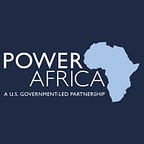Changing Careers: From Medicine to Renewable Energy
Dr. Caleb King, an American physician and the founder and CEO of Amahoro Energy, talks about why he decided to start building hydropower plants in Rwanda and partner with Power Africa
When I arrived in Rwanda 13 years ago, it was not to work in the renewable energy field. I heard about a hospital that had been closed for nine years after the genocide, and I came to reopen it with the help of my wife and her father and stepmother — all four of us are doctors.
But we encountered a major problem: no electricity.
We had an old, donated generator and a little bit of solar power to run computers. But apart from that, we didn’t have the kind of electricity needed to do the routine activities of the hospital day-to-day: lighting for operations, or electricity for an incubator.
With the help of the Rwandan government and about 150 local staff, we got the hospital up and running and made do without. After a few years, I asked the director of the Rwandan utility for an electricity line out to the hospital. He told me there was a shortage of electricity, and installing a line would be expensive.
Instead, he suggested: “How about you make your own power?”
He told us if we did this, he could put a line out to attach us to the grid; this meant if our power plant went down, there would still be electricity. It was an unusual request, but we explored opportunities and eventually came up with plans to have the hospital hooked up to the national grid, powered by the first plant we worked on.
That is how my company Amahoro Energy was born.
Fortunately, I happened to have a background in civil environmental engineering at MIT. I wasn’t sure how I would ever use that PhD because I wanted to be on the ground serving as a doctor. I had sort of forgotten about it until I was awakened that day, so to speak, by the director of the utility.
At the time, bringing the private sector into small hydropower in Rwanda was encouraged by the Dutch government and the German aid organization GIZ. We were among the first companies to be involved.
Our goal became bigger than just providing for a hospital; it was to set up a model for independent power producers that could be reproduced all around the country.
The idea was that our small hydroelectric plant and others like it could feed into the grid at multiple sites, eventually doubling the electric grid capacity of the country — one megawatt at a time.
Our first project, the Musarara Plant, is a 450 KW run-of-the-river hydropower plant operating on the Gaseke River. Musarara has now been supplying Rwanda with clean, renewable energy since 2013.
Now we are starting construction on a second project: the Nyundo Plant, on the Mukungwa River. When completed, it will produce 5 MW of electricity, around 5 percent of Rwanda’s current consumption.
The feasibility study for our first plant was funded by the U.S. Trade and Development Agency (USTDA), one of the 12 Power Africa U.S. Government agencies. USTDA works to optimize investment opportunities in potential markets for U.S. goods and expertise. It doesn’t require us to buy American products, but it encourages us to look into U.S. sources and to see where there’s a fit.
For instance, for this next project the fiberglass pipe winding equipment is all made in the U.S., and we found that the best value equipment for us is made in Washington state.
Also, U.S. companies make hydro power equipment, electrical equipment, generators and transformers. With the U.S. being so big, manufacturers aren’t looking outside the borders for places like Rwanda in particular, so programs like USTDA help U.S. manufacturers get paired up with people like us working in Rwanda so that we can use American goods where they’re most beneficial.
However, for other components, such as the very large pipe used to divert river water, we decided to have this manufactured here in rural Rwanda near the site, since it would be expensive to transport. We are creating the first manufacturing facility for large-diameter fiberglass pipes in sub-Saharan Africa.
Power Africa, besides connecting us with funding for a feasibility study, also helped us speed up our timeline to break ground on the project.
We needed a concession agreement and an amendment to our power purchase agreement, which can take months. So, we put forward our case to the U.S. Embassy team, along with the Power Africa coordinator, USTDA staff and other officials, and they were able to get a high-level meeting with the Minister of Infrastructure, with the mediation of the U.S. Ambassador, to push the Rwanda utility to move quickly on these steps.
What Power Africa provides is a framework for investors to think outside the box of where they usually put their money.
Anyone who puts their money in renewable energy in Africa now should be able to find returns of 20 percent, which compares well to any other kind of investment.
The good part about that is not just seeing returns, but feeling that the money is well spent, that it’s having an impact. It’s helping people that I see every day — people harvesting sweet potatoes and tending sheep and goats. These are the kind of people who benefit from energy projects in Rwanda, not just people sitting behind big desks in big cities.
Follow Power Africa on Facebook and Instagram and subscribe to our newsletter.
